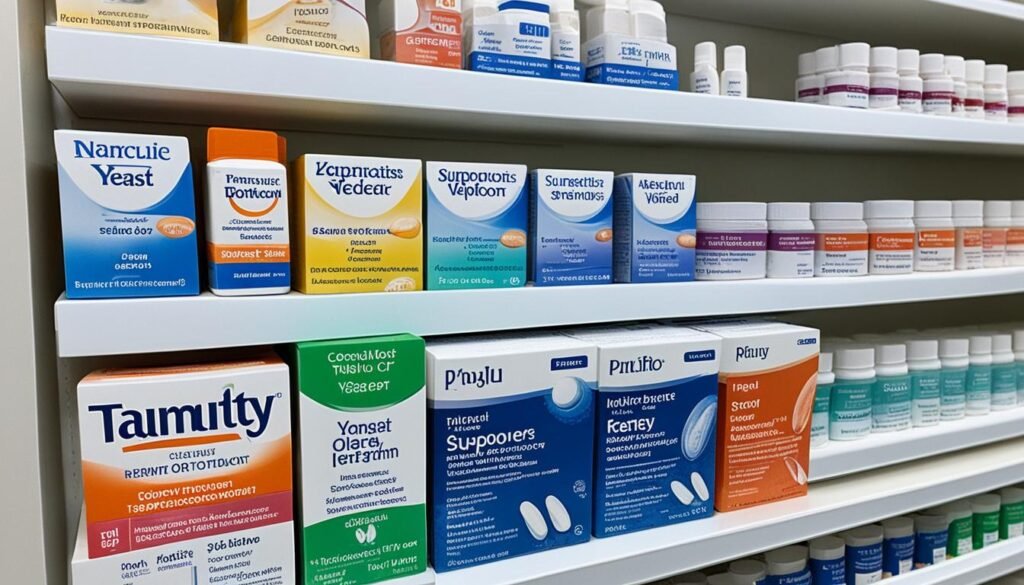A vaginal yeast infection, also known as vulvovaginal candidiasis, is a common condition caused by an overgrowth of the Candida albicans fungus. If you’re experiencing symptoms such as vaginal itching, burning, and a thick, white discharge, finding the best treatment for yeast infection is essential to alleviate discomfort and restore balance.
This article will explore different treatment options for yeast infections, including natural remedies and over-the-counter medications. Whether you prefer a holistic approach or a quick and convenient solution, we’ve got you covered. Our comprehensive guide will help you decide to address your yeast infection effectively.
In the next section, Let’s begin by exploring the power of natural remedies for yeast infection. These remedies are known for their efficacy and minimal side effects, making them popular choices among individuals seeking alternative treatments.
Natural Remedies for Yeast Infection
Natural remedies can be a beneficial and affordable way to treat yeast infections. While they may not work for everyone, many people find relief from their symptoms using these natural remedies. Here are some popular natural remedies for yeast infections:
1. Probiotics: Probiotics, such as lactobacillus acidophilus, can help restore the balance of good bacteria in your body, which may help fight off the overgrowth of yeast. You can find probiotic supplements or consume foods rich in probiotics, like yogurt or kefir.
2. Garlic: Garlic has been used for centuries for its antifungal properties. You can consume raw garlic or take garlic supplements to help combat a yeast infection. However, it’s important to note that excessive consumption of garlic can have side effects, so always consult with a healthcare professional before trying this remedy.
3. Tea tree oil: Tea tree oil has natural antifungal properties and can be used topically to treat yeast infections. Mix a few drops of tea tree oil with a carrier oil, such as coconut oil, and apply it to the affected area. Remember to dilute the tea tree oil, as it can cause skin irritation when undiluted.

4. Yogurt: Plain, unsweetened yogurt contains live cultures of lactobacillus acidophilus, which can help restore the balance of good bacteria in your body. You can apply yogurt topically to the affected area or consume it orally. Make sure to choose yogurt without added sugars or flavors.
5. Coconut oil: Coconut oil has natural antifungal properties and can be applied topically to alleviate yeast infection symptoms. Gently apply a thin layer of coconut oil to the affected area. Remember to choose organic, virgin coconut oil for the best results.
6. Cranberry juice: Cranberry juice is known for its ability to prevent urinary tract infections, but it may also assist in preventing yeast infections. Drinking unsweetened cranberry juice regularly can help maintain a healthy urinary tract and potentially avoid yeast overgrowth.
While natural remedies can be effective, it’s important to note that they may not work for everyone. If you experience severe or persistent symptoms, it is recommended that you consult a healthcare professional for proper diagnosis and treatment.
Over-the-counter medications offer convenient and effective relief for yeast infections without prescription. These treatments alleviate discomfort and symptoms associated with the disease.
Antifungal Ingredients
The most common over-the-counter treatments contain antifungal agents like miconazole or terconazole. These ingredients specifically target and eliminate the Candida albicans fungus responsible for yeast infections.
Variety of Forms
Over-the-counter yeast infection medications come in various forms, including:
- Creams and Ointments: Applied directly to the affected area for external relief.
- Tablets and Suppositories: Designed for internal use, providing targeted treatment.
Proper Usage
It’s crucial to carefully read and follow the instructions provided with your chosen product. Proper application and adherence to usage guidelines ensure the best results in treating the infection.
Seeking Professional Guidance
If symptoms persist or worsen after treatment, consulting a healthcare professional is recommended for further evaluation and guidance.
Consideration
If experiencing yeast infection symptoms, trying an over-the-counter treatment can offer relief. Always consult a healthcare professional with any concerns or questions regarding your condition.

Dealing with recurrent yeast infections can be frustrating, but proactive steps can help prevent and manage them effectively.
Hygiene Practices
- Keep Clean and Dry: Maintain genital hygiene by keeping the area clean and dry. Avoid harsh soaps and douching, which can disrupt the natural balance.
- Choose Breathable Fabrics: Opt for breathable fabrics like cotton to minimize moisture buildup and promote airflow, reducing the risk of yeast growth.
Dietary Adjustments
- Limit Sugary Intake: Reduce consumption of sugary foods and drinks, as yeast thrives on sugar. Emphasize a balanced diet rich in fruits, vegetables, whole grains, and lean proteins.
- Incorporate Probiotics: Include probiotic-rich foods like yogurt to promote healthy gut bacteria, which may help prevent yeast overgrowth.
Lifestyle Habits
- Avoid Tight Clothing: Steer clear of tight-fitting underwear and pants, which can create a warm, moist environment conducive to yeast growth.
- Maintain Good Health: Manage underlying health conditions such as diabetes or immune system weaknesses, as these can increase susceptibility to infections.
Seeking Professional Guidance
- Consult a Healthcare Professional: If recurrent yeast infections persist despite preventive measures, seek guidance from a healthcare professional.
- Tailored Management Strategies: Work with your healthcare provider to develop personalized management strategies based on your circumstances.
Taking proactive steps and maintaining good hygiene and dietary and lifestyle habits can significantly reduce recurrent yeast infections. Consulting a healthcare professional for guidance and tailored management strategies is essential for effective prevention and management.

East infections stem from various factors, including hormonal shifts, antibiotic usage, weakened immunity, and excessive sugar intake. Such factors disrupt the delicate balance of bacteria and yeast in the vagina, fostering an overgrowth of Candida albicans fungus, the culprit behind yeast infections.
Common Symptoms
- Vaginal Itching: Persistent and uncomfortable itching in the vaginal area.
- Burning Sensation: Irritating sensation, often during urination or general movement.
- Abnormal Discharge: Noticeable changes in vaginal discharge, typically thicker or cottage cheese-like.
- Discomfort During Intercourse: Pain or discomfort experienced during sexual activity.
Importance of Recognition and Treatment
These symptoms can significantly impact daily life. Prompt recognition and treatment are crucial to alleviate discomfort and prevent potential complications. Ignoring symptoms or self-diagnosis may exacerbate discomfort and raise the risk of complications.
Seeking Professional Guidance
If experiencing these symptoms, consulting a healthcare professional is recommended for accurate diagnosis and tailored treatment. Healthcare providers can identify underlying causes, prescribe appropriate treatments, and suggest preventive measures to mitigate future occurrences.
Understanding yeast infection symptoms and causes empowers individuals to seek timely and adequate medical assistance, enhancing overall well-being and comfort.
Diagnosis and Treatment Options
Diagnosing a yeast infection involves a pelvic exam and the collection of a vaginal fluid sample for analysis. Healthcare professionals will carefully examine the vaginal area and may also ask about your symptoms and medical history to ensure an accurate diagnosis. Collecting a sample of vaginal fluid allows for further analysis to confirm the presence of a yeast infection.
Once diagnosed, there are several treatment options for yeast infections. Treatment choice depends on the severity and frequency of the diseases, individual factors, and preferences. Here are some standard treatment options:
1. Short-Course Vaginal Therapy with Antifungal Medications
This treatment involves using antifungal creams, ointments, or suppositories that are inserted directly into the vagina. These medications work by killing the yeast causing the infection and relieving symptoms. Short-course vaginal therapy is typically recommended for mild to moderate yeast infections.
2. Single-Dose Oral Medication
Sometimes, a single-dose oral medication may be prescribed to treat a yeast infection. This medication works systemically to eliminate the yeast throughout the body. It is generally more convenient for individuals who prefer oral medication or have recurring yeast infections.
3. Long-Course Vaginal Therapy
In cases of severe or recurrent yeast infections, long-course vaginal therapy may be necessary. This treatment involves using antifungal medications for a longer duration, typically 7 to 14 days. Long-course therapy helps ensure complete yeast eradication and reduces the risk of recurrence.
4. Azole-Resistant Therapy for Resistant Strains of Candida
Alternative treatment options may be necessary in rare cases of azole-resistant yeast infections. This may include using other antifungal medications, such as echinocandins or topical nystatin. A healthcare professional will determine the most appropriate treatment based on the specific circumstances.
It’s important to note that self-diagnosis and self-treatment without medical advice may not effectively resolve a yeast infection. Always consult a healthcare professional for an accurate diagnosis and appropriate treatment options.
Remember, everyone’s experience with yeast infections may differ, and it’s essential to follow the guidance of a healthcare professional for the most effective and safe treatment.
When to Seek Medical Advice for Yeast Infections
Seeking medical advice for yeast infections is crucial for accurate diagnosis, effective treatment, and preventive guidance. Here’s when to consult a healthcare professional:
First-Time Symptoms
- If experiencing symptoms of a yeast infection for the first time, it’s essential to seek medical advice for proper diagnosis and treatment initiation.
Persistent or Worsening Symptoms
- Even if attempting self-treatment, persistent or worsening symptoms warrant medical consultation. Healthcare professionals can assess your condition and recommend appropriate treatment adjustments.
Expert Diagnosis and Treatment
- Healthcare professionals offer expertise in diagnosing and treating yeast infections. Consulting them ensures you receive tailored treatment for your needs, enhancing symptom relief and preventing complications.
Preventive Guidance
- Healthcare providers offer valuable advice on preventing future infections and managing recurrent yeast infections. They can recommend hygiene practices, suitable vaginal products, and lifestyle modifications to reduce the risk of future occurrences.
Proactive Health Management
- Consulting a healthcare professional empowers you to understand your condition better and take proactive steps toward optimal health. They provide support, guidance, and expert care to help you effectively manage yeast infections and improve overall well-being.
Remember, your healthcare provider is your partner in health. If unsure about symptoms or experiencing concerns, seeking medical advice ensures timely and appropriate care, leading to relief from yeast infection discomfort and improved quality of life.
Images Credit: All images are AI-Generated.
Disclaimer: The images, videos & logos displayed on bestfordaily.com are used for informational purposes only. We make every effort to credit the original copyright holder whenever possible. If you are the owner of any content used on this blog and do not wish for it to appear here, please contact us.
Author
-

Hey there! I'm Andrew Reed, and I live for the thrill of writing reviews. Dive into my world at bestfordaily.com, where I unpack stories behind products and experiences. I'm all about sharing my unique take on things, infusing each review with my youthful enthusiasm and a dash of social flair. Join me on this exciting journey—I promise you won't just read reviews; you'll experience them!
View all posts






